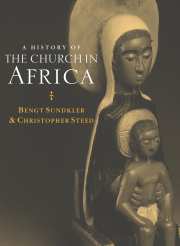Book contents
- Frontmatter
- Contents
- List of maps
- Acknowledgements
- List of abbreviations
- Introduction
- PART I THE FIRST FOURTEEN HUNDRED YEARS
- PART II THE MIDDLE AGES 1415 – 1787
- PART III THE LONG NINETEENTH CENTURY 1787 – 1919
- PART IV THE COLONIAL EXPERIENCE 1920 – 1959
- PART V INDEPENDENT AFRICA 1960 – 92
- 18 Introduction to Independent Africa
- 19 North and North-Eastern Africa
- 20 West Africa
- 21 Central Africa
- 22 Southern Africa
- 23 East Africa
- 24 Ecumenical Perspectives
- 25 Epilogue
- Notes
- Bibliography
- Name index
- Subject index
22 - Southern Africa
from PART V - INDEPENDENT AFRICA 1960 – 92
Published online by Cambridge University Press: 16 September 2009
- Frontmatter
- Contents
- List of maps
- Acknowledgements
- List of abbreviations
- Introduction
- PART I THE FIRST FOURTEEN HUNDRED YEARS
- PART II THE MIDDLE AGES 1415 – 1787
- PART III THE LONG NINETEENTH CENTURY 1787 – 1919
- PART IV THE COLONIAL EXPERIENCE 1920 – 1959
- PART V INDEPENDENT AFRICA 1960 – 92
- 18 Introduction to Independent Africa
- 19 North and North-Eastern Africa
- 20 West Africa
- 21 Central Africa
- 22 Southern Africa
- 23 East Africa
- 24 Ecumenical Perspectives
- 25 Epilogue
- Notes
- Bibliography
- Name index
- Subject index
Summary
ZAMBIA
Zambia's freedom movement under Dr Kenneth Kaunda was an African response to the European-inspired and -dominated Central African Federation. Kaunda (b. 1925) began as a teacher and was the son of the Revd David Kaunda who, as we recall, built a solid Presbyterian Church in the north-western part of the country. Kenneth Kaunda himself had his experience of opposition and imprisonment – a ‘prison graduate’ – and became president of the country in 1964. ‘Humanism’ was his philosophy, humanism with a Christian theme:
What we loosely call ‘independence’, ‘freedom’, ‘uhuru’ etc. will be meaningless unless MAN is put first … If I overemphasize the importance of MAN it is because I fear that young countries are in danger of repeating the mistakes of older countries both of the East and the West where material development and plans to advance have become more important than MAN for whom these plans after all are made or supposedly made … The forces and tools of progress are here – let us use them.
The beginnings of the new nation were marred by the Lumpa rebellion, led by a prophetess Alice Lenshina. Coming from the same district as the president she had, like so many African prophets, both men and women, had a revelation of God. She had ‘died’ and ‘been with Jesus’ in heaven: He told her to proclaim God's message to the world.
- Type
- Chapter
- Information
- A History of the Church in Africa , pp. 974 - 999Publisher: Cambridge University PressPrint publication year: 2000



